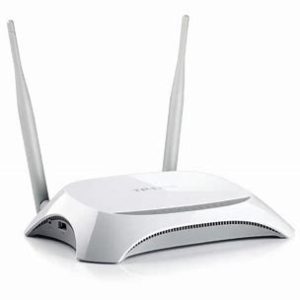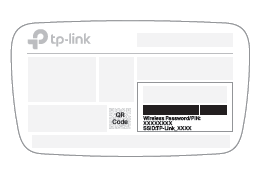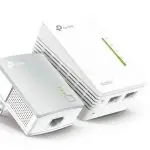
tp-link Wireless N Router Installation Guide
Quick Installation Guide
Wireless N Router
Note: TL-WR841N is used for demonstration in this guide. Images may differ from actual products
Router Mode
If your internet comes from an Ethernet outlet, connect the router’s WAN port to it, then skip
steps 1, 2, and 3.

Configure the router
- Connect your computer to the router (Wired or Wireless)
Wired
Turn off the Wi-Fi on your computer and connect it to the router via an Ethernet cable.
Wireless
A. Find the product label at the bottom of the router. B. Use the default network name (SSID) and password to join the network.
Tip: If you are using a smartphone or tablet, you can also scan the QR code to join the preset network directly.

- Launch a web browser, and enter http://tplinkwifi.net or http://192.168.0.1 in the address bar. Create a password to log in.
Note: If the login window does not appear, please refer to FAQ > Q1

- Click Next to start the Quick Setup. Select Wireless Router and follow the step-by-step instructions to set up the internet connection.
Note: If you are not sure of the WAN Connection Type, please click Auto-Detect.

Tether App
The TP-Link Tether app provides a simple, intuitive way to access and manage your router. Scan the QR code to download Tether from the Apple
App Store or Google Play

Access Point Mode
In this mode, the router transforms your existing wired network to a wireless one.

A. Power on the router.
B. Connect the router’s WAN port to your wired router’s Ethernet port via an Ethernet cable as shown above.
C. Connect a computer to the router via an Ethernet cable or wirelessly by using the SSID (network name) and Wireless Password printed on the label at the bottom of the router.
D. Launch a web browser and enter http://tplinkwifi.net in the address bar. Create a password to log in.
E. Click Next to start the Quick Setup. Select Access Point and follow the step-by-step instructions of the Quick Setup to set up the internet connection
Range Extender Mode
In this mode, the router boosts the existing wireless coverage in your home
1. Configure
A. Place the router next to your host router and power it on.
B. Connect a computer to the router via an Ethernet cable or wirelessly by using the SSID (network name) and Wireless Password printed on the label at the bottom of the router.
C. Launch a web browser and enter http://tplinkwifi.net in the address bar.
Create a password to log in.
D. Click Next to start the Quick Setup. Select Range Extender and follow the step-by-step instructions to set up the internet connection. In this mode, the router boosts the existing wireless coverage in your home. Place the router about halfway between your host router and the Wi-Fi “dead” zone. The location you choose must be within the range of your existing host network

WISP Mode
In this mode, the router connects to the ISP network wirelessly in areas without wired service.

A. Power on the router.
B. Connect a computer to the router via an Ethernet cable or wirelessly by using the SSID (network name) and Wireless Password printed on
the label at the bottom of the router.
C. Launch a web browser and enter http://tplinkwifi.net in the address bar. Create a password to log in.
D. Click Next to start the Quick Setup. Select WISP and follow the step-by-step instructions to set up the internet connection
Appearance
| Item | Description | |
| Internet LED | Orange | Solid on: Router Mode: The WAN port is connected, but internet is not available. Access Point Mode: The WAN port is not connected. Range Extender Mode: The router is not connected to the host network. WISP Mode: Internet is not available Blinking: The WAN port is not connected while in Router Mode. |
| Green | Solid on: Router/WISP Mode: Internet is available. Access Point Mode: The WAN port is connected. Range Extender Mode: The router is connected to the host network. Blinking: The system is starting up or firmware is being upgraded*. |
|
| LAN LED | Green | Solid on: At least one LAN port is connected. |
| Wi-Fi LED | Green | Solid on: Wireless function is enabled. Blinking: WPS connection is in progress. This may take up to 2 minutes. |
| WPS/RESET Button |
Press for 1 second to enable the WPS function. Press for more than 5 seconds to reset the router to its factory default settings |
|
To avoid device damage, do not disconnect or power off your router during the upgrade
FAQ (Frequently Asked Questions)
Q1. What can I do if the login window does not appear?
- Reboot your router and try again.
- If the computer is set to a static IP address, change its settings to obtain an IP address and DNS server address automatically.
- Verify that http://tplinkwifi.net or http://192.168.0.1 is correctly entered in the web browser. Alternatively, enter http://192.168.1.1 in the web browser and press Enter.
- Use another web browser and try again.
- Disable and then enable the network adapter being used.
Q2. What can I do if I cannot access the internet when in Router mode?
- Reboot your modem and router, then try again. Check if the internet is working normally by connecting a computer directly to the
- modem using an Ethernet cable. If it is not, contact your Internet Service Provider.
Log in to the web management page of the router, and go to the Status page to check whether the WAN IP address is valid or not. If it is, please run the Quick Setup
again; otherwise, recheck the hardware connection. - For cable modem users, log in to the web management page of the router. Go to Network > MAC Clone, select Clone MAC Address and click Save. Then reboot
- both the modem and the router.
Q3. How do I restore the router to its factory default settings?
- With the router powered on, press and hold the WPS/RESET button on the back panel of the router for more than 5 seconds until the Internet LED blinks. The router
will reboot. - Log in to the web management page of the router. Go to System Tools > Factory Defaults, and click Restore. The router will restore and reboot automatically
Q4. What can I do if I forgot my web management password?
- Refer to FAQ > Q3 to reset the router, and then create a password to log in.
Q5. What can I do if I forgot my wireless network password?
- The factory default wireless password is printed on the label of the router.
- Connect a computer directly to the router using an Ethernet cable. Log in to the router’s web management page, and go to Wireless > Wireless Security to obtain
or reset your wireless password
Safety Information
- Keep the device away from water, fire, humidity or hot environments.
- Do not attempt to disassemble, repair, or modify the device.
- Do not use damaged charger or USB cable to charge the device.
- Do not use any other chargers than those recommended.
- Do not use the device where wireless devices are not allowed.
- Adapter shall be installed near the equipment and shall be easily accessible
For technical support, replacement services, user guides, and other information, please visit https://www.tp-link.com/support,
or simply scan the QR code.

